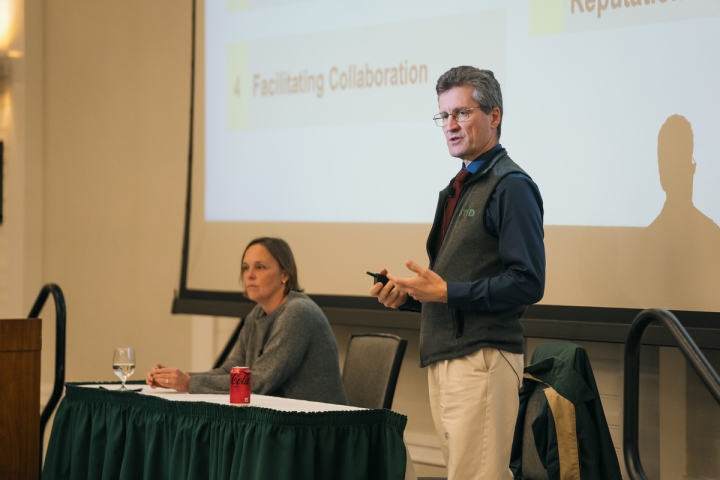At two town hall-style forums this week, Provost David Kotz ’86 and Niehaus Family Professor in International Studies Nina Pavcnik presented a progress report on the Arts and Sciences Future Project. A total of more than 100 members of the faculty and staff attended the sessions, one in-person and the other online.
The project was launched in early 2022 when then-President Philip J. Hanlon ’77 asked Dean of the Faculty Elizabeth F. Smith to explore potential new organizational and budget models for the Arts and Sciences. President Sian Leah Beilock appointed Kotz and Pavcnik, who is special adviser to the president for major institutional priorities, to co-lead the steering committee that will guide the project through its next phase.
In remarks to the meeting of the General Faculty earlier this month, President Beilock said the project is helping the institution think about its organization in a way that “not only centers the Arts and Sciences at Dartmouth, but gives faculty a strong voice and makes clear how we can better collaborate across schools.”
At the online session on Tuesday, Kotz emphasized that any model Dartmouth ultimately adopts will not change Dartmouth’s commitment to undergraduate liberal arts education or its undergraduate curriculum, and that the goal of the project “is not about budget cuts.”
Rather, the project seeks to create a new structure that positions Arts and Sciences to better deliver on its whole mission—research and education—and to have the autonomy and authority to allocate resources (and increase resources) in support of that mission.
Currently, Dartmouth’s undergraduate Arts and Sciences operation has two leaders: a dean of faculty, who reports to the president, and a dean of the College, overseeing student affairs, who reports to the provost.
Crucially—unlike most peer institutions—decisions within Arts and Sciences that affect everything from staffing and admissions to programs and fundraising currently require approval from Dartmouth’s central administration. Funds generated from undergraduate tuition and philanthropy are allocated to the institution’s central operations, out of which Arts and Sciences gets an allowance. This current structure makes it challenging for faculty and student affairs staff to work together and doesn’t incentivize innovation or cross-institutional collaboration.
A restructured model would establish a new leader—reporting to either the president or the provost—“who wakes up every day and has the holistic mission of the Arts and Sciences as their sole focus,” Kotz said.
Pavcnik said such a structure would “give Arts and Sciences faculty and staff a better platform to advocate” for their needs and allocate resources accordingly, allowing the division to decide its own priorities, like a school.
Aligning the Arts and Sciences budget with its priorities would create “incentives to collaborate, to innovate, and it could expand opportunities for collaborative research and scholarship, both within Arts and Sciences as well as more broadly” throughout the institution, Pavcnik said—and potentially lead to the development of new programs, such as “joint degrees with professional schools, providing new opportunities to generate revenue.”
A reorganization would also create opportunities to improve the undergraduate experience by making it easier for faculty and staff to support each other’s work in areas such as student advising and admissions.
The Guarini School of Graduate and Advanced Studies, Geisel School of Medicine, Thayer School of Engineering, and Tuck School of Business each have a single dean, reporting to the provost, who is responsible for both faculty and students. The schools also have budgetary autonomy in allocating resources to deliver on their mission.
During the question and answer periods, Kotz and Pavcnik were asked, among other issues, about budget transparency; how faculty and staff collaboration, fundraising, and admissions might change in a new structure; and if the new structure would require additional staff.
Kotz outlined the project’s next steps. This fall, working groups are preparing a proposal for which they will solicit feedback during the winter term. That proposal will be presented to the Board of Trustees in March.
“Assuming the feedback seems to indicate that we’re going in the right direction,” Kotz said, the revised proposal would then go through the faculty governance process in the spring, which would likely include votes from the General Faculty and from each of the schools. It would then be presented to trustees for final approval in June 2024.
More information and answers to frequently asked questions are available on the project website.

